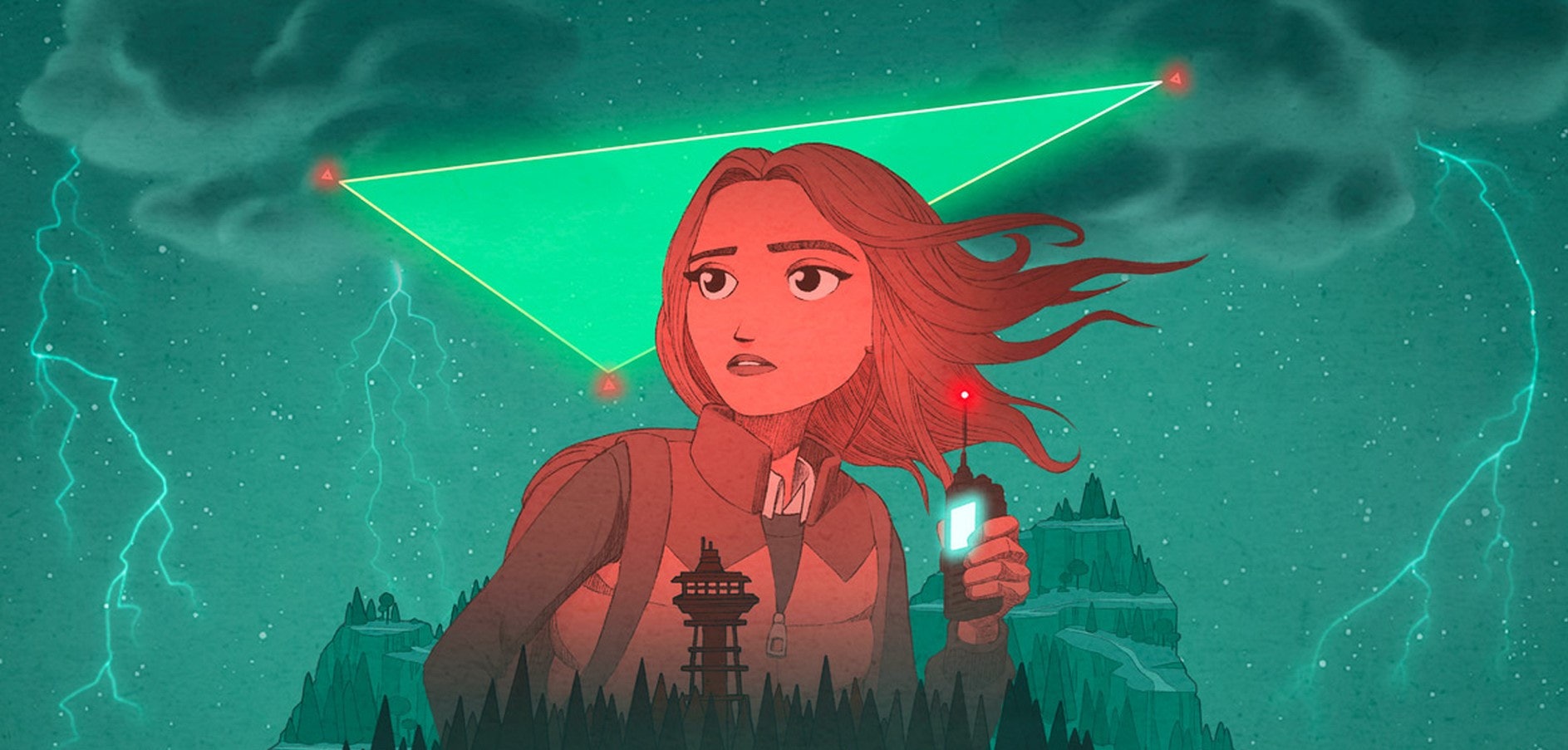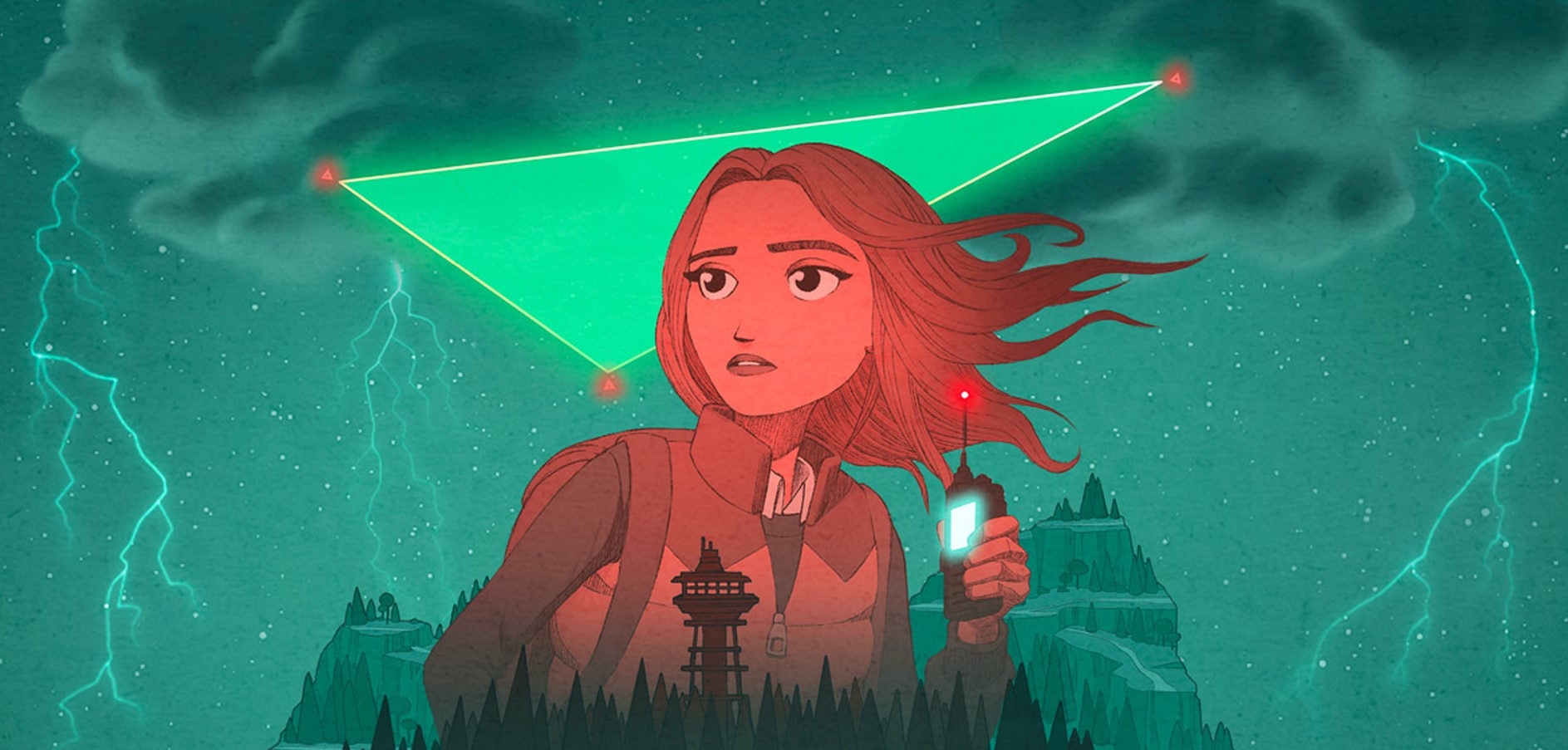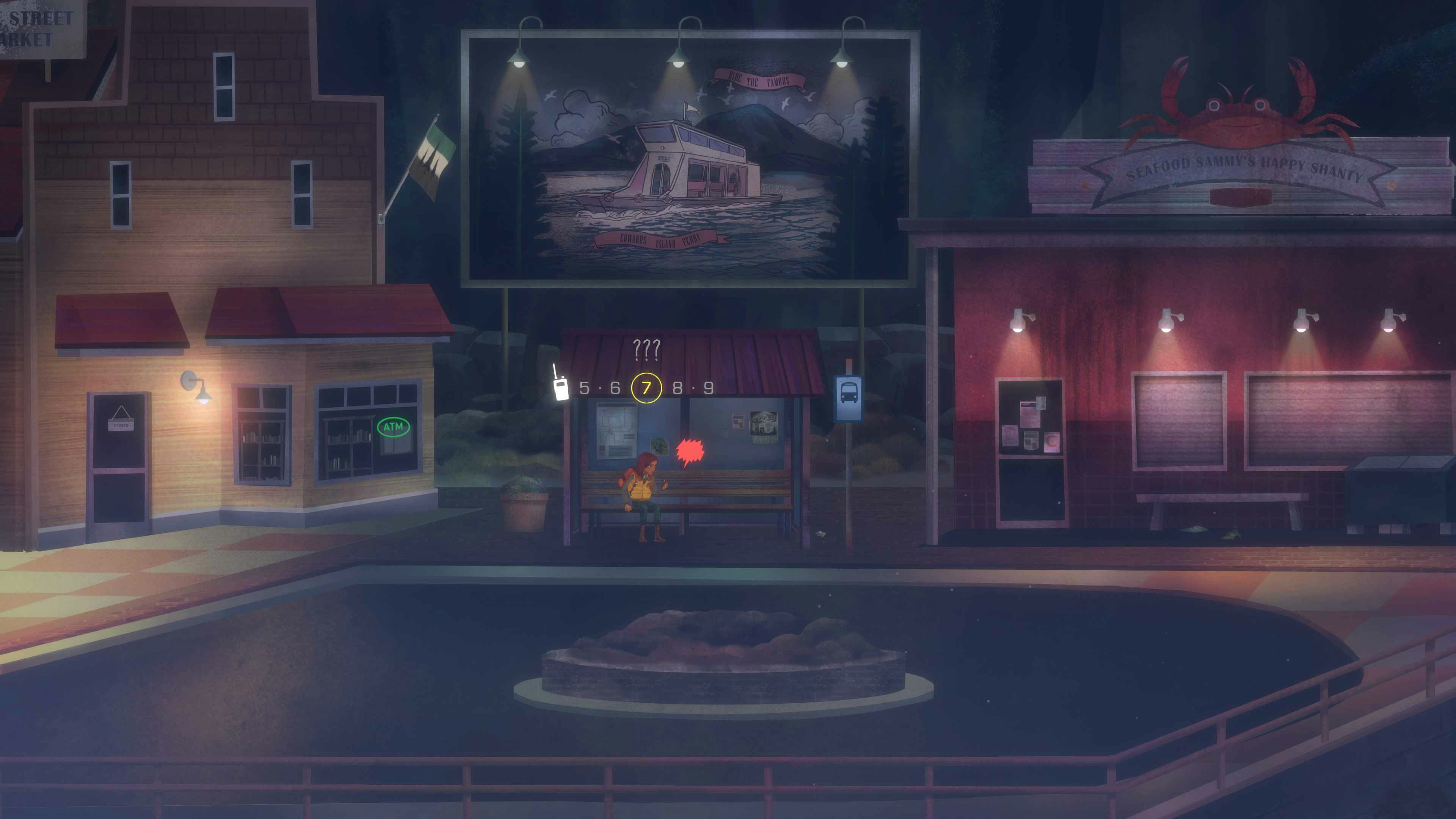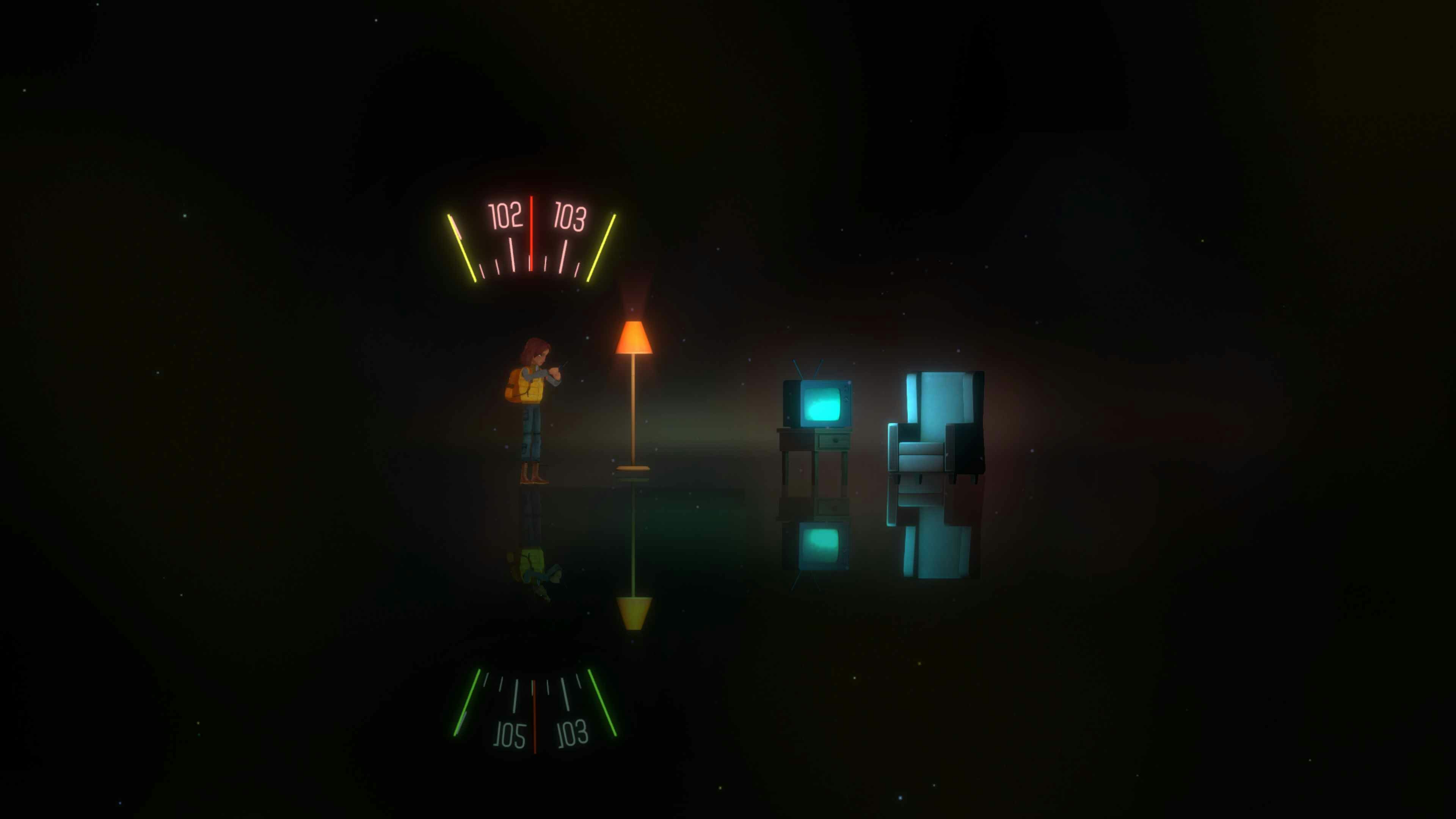
Just as I thought getting trapped in a church with a ghost was bad enough, the spectral enemy shifts the rules of reality. The world turns on its side, furniture falling from its once stable positions on the ground. My body slides ever closer to a door, as a menacing open space looms beyond.
This stunning set piece occurs halfway into Oxenfree II: Lost Signals and accompanies an equally perspective-shifting narrative twist that sheds light on the game’s central mysteries. But just as the building’s furniture never returns to its rightful place, Oxenfree II never finds its footing after this point.
Seven years after the release of the first Oxenfree, Night School Studio has returned to tell a new story in its fictional slice of Oregon. What begins as a promising sequel defined by a complex protagonist and meaningful themes soon devolves into an experience that gets lost in the shadow of its predecessor.

Let’s Do the Time Warp Again
Five years after the events of Oxenfree, new protagonist Riley returns to her hometown of Camena. She hopes that her new job planting radio transmitters across the town’s highest points will finally bring the sense of security that has been absent in her life. However, her life gets even stranger when a trio of troublesome teens opens a portal in space-time that leaves Riley and new coworker Jacob stuck trying to save the town from destruction.
Riley isn’t the only aspect of Oxenfree II that is new. While Alex only had access to a radio in the first game, Riley has the added use of a walkie-talkie. With nine channels, this lets her talk to a colorful cast at will, from her supervisor Evelyn to Maria, the host of the local high school's radio show. Making time to call will impact how each character makes it through the night, and some offer short detours from the main path.
While Jacob and Riley will find themselves stuck in short time loops (a familiar occurrence to players of Oxenfree) the impact on the world is larger in Oxenfree II, with rifts in time popping up across Camena. Riley is able to tune into these tears and explore different time periods of Camena’s history, leading to new puzzles and lore.

Most frustrating is what hasn’t changed. Despite being a short game at roughly five to six hours in total, moving Riley through the world feels like a chore. The game’s restrictive paths constantly fight the player, and I found myself desperately wishing for a run button.
The slowness of movement is intended to give the constant dialogue room to breathe, yet there is so much incessant chatter (none of which is as sharp as Oxenfree’s) that to hear everything someone has to say Riley will be standing still for minutes on end.
Walkie-Talkie Killed the Radio Star
Despite the new additions, much of Oxenfree II feels distinctly empty. The best example of this is the new location of Camena. While the game map is bigger than Oxenfree’s Edwards Island, the space itself lacks a sense of possibility, with little to reward eager explorers. There are some side trails, but the experience on offer here is mostly a linear walk through town.
Edwards Island felt like a lived-in location, brimming with history and secrets to uncover. Camena is two-dimensional in comparison. The bulk of Riley’s adventure occurs in environments that are just variations of wooded paths.
This lack of freedom extends to the gameplay. Oxenfree’s core mechanic — beyond branching dialogue — was the radio. By tuning into certain frequencies, players could learn more about Edwards Island, open new areas, hunt down lost letters, and find mysterious messages over the radio waves that gave insight into the fascinating enemy. It was an incredibly versatile tool that revealed a world of mystery to the player.

The addition of the walkie-talkie takes some utility away from the radio, which makes both mechanics feel lacking. While you can learn about Camena and uncover the occasional mystery with the walkie-talkie, the radio feels entirely useless beyond mandated story beats. The walkie-talkie also houses most of the supporting cast beyond Jacob, meaning we never get the interesting group dynamic of Oxenfree.
The radio is now relegated to being a machine for supernatural occurrences to play out like audio drama. There are only a handful of channels and beyond Maria’s radio show, none of them have any relevance to Oxenfree II’s plot. While a man spookily talking about being trapped somewhere sure does fit the vibe, it can be ignored without consequence. Oxenfree’s central mystery was a constant presence on the in-game radio. There was a narrative purpose and cohesion to everything. But Oxenfree II’s radio is mostly just noise.
Over and Out
Oxenfree II presents something of a paradox. In an interview with Gamereactor during Summer Game Fest Play Days 2023, lead writer Adam Hines said, “You can jump into the sequel kind of cold.” This isn’t entirely true.
To put it in a way that sounds like nonsense, those who have played Oxenfree will have a more complete understanding of the story of Oxenfree II — but they are also less likely to enjoy the sequel because of how familiar its narrative feels. Those who have never played Oxenfree are more likely to enjoy the story of Oxenfree II, even if they won’t have any clue what is happening at the game’s conclusion.

This is a result of the game’s biggest stumbling. Riley is a fascinating protagonist, with a fascinating story that compliments Alex’s journey. Oxenfree centers on Alex’s struggle with the loss of her brother, and her unwillingness to move on, which is supported by the game’s time loops and her flashbacks to moments with her brother.
In the sequel, Riley is plagued by visions of her future, which take the form of conversations with a young boy named Rex. She is almost paralyzed by the possibility that her life is already decided and her mistakes can never be fixed. These narratives are two sides of the same coin. Yet halfway through Oxenfree II, Riley’s narrative is sidelined in order to retread the same ground as the first game. It’s a heartbreaking betrayal, and Riley never truly regains her spotlight as the game’s central concern.
The first game’s most rewarding ending taught Alex that despite loss and heartache, she needed to move on. Oxenfree II: Lost Signals backpedals on this sentiment and refuses to let go of the past.
6/10
Oxenfree II: Lost Signals is available now for PC, Mac, PlayStation, Nintendo Switch, and Android/iOS via Netflix (for subscribers). Inverse reviewed the game on PC.
INVERSE VIDEO GAME REVIEW ETHOS: Every Inverse video game review answers two questions: Is this game worth your time? Are you getting what you pay for? We have no tolerance for endless fetch quests, clunky mechanics, or bugs that dilute the experience. We care deeply about a game’s design, world-building, character arcs, and storytelling come together. Inverse will never punch down, but we aren’t afraid to punch up. We love magic and science-fiction in equal measure, and as much as we love experiencing rich stories and worlds through games, we won’t ignore the real-world context in which those games are made.







